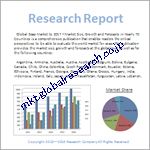目次
第1章.世界のヘルスケアIT市場 エグゼクティブサマリー
1.1.ヘルスケアITの世界市場規模・予測(2022年~2032年)
1.2.地域別概要
1.3.セグメント別概要
1.3.1.用途別
1.3.2.配信モード別
1.3.3.最終用途別
1.4.主要動向
1.5.アナリストの提言と結論
第2章.世界のヘルスケアIT市場の定義と調査前提
2.1.調査目的
2.2.市場の定義
2.3.調査の前提
2.3.1.包含と除外
2.3.2.限界
2.3.3.供給サイドの分析
2.3.3.1.インフラストラクチャー
2.3.3.2.規制環境
2.3.3.3.競争環境
2.3.4.需要サイド分析
2.3.4.1.技術の進歩
2.3.4.2.消費者の認識と採用
2.4.推定方法
2.5.調査対象年
第3章.ヘルスケアITの世界市場ダイナミクス
3.1.市場促進要因
3.1.1.EHRと遠隔医療ソリューションの採用拡大
3.1.2.AIとクラウドベースのソリューションの進歩
3.1.3.デジタルヘルスを支援する政府の取り組み
3.2.市場の課題
3.2.1.高い導入コスト
3.2.2.医療ITシステムにおける相互運用性の問題
3.3.市場機会
3.3.1.臨床判断支援システムへのAIの統合
3.3.2.新興市場におけるヘルスケアITの拡大
第4章.世界のヘルスケアIT市場産業分析
4.1.ポーターのファイブフォース分析
4.1.1.サプライヤーの交渉力
4.1.2.バイヤーの交渉力
4.1.3.新規参入者の脅威
4.1.4.代替品の脅威
4.1.5.競合他社との競争
4.2.PESTEL分析
4.2.1.政治的
4.2.2.経済
4.2.3.社会
4.2.4.技術
4.2.5.環境
4.2.6.法律
第5章.ヘルスケアITの世界市場規模・用途別予測(2022〜2032年)
5.1.セグメントダッシュボード
5.2.ヘルスケアITの世界市場:アプリケーション別収益動向分析(USD Million)
5.2.1.電子カルテ(EHR)
5.2.2.コンピュータ化された医療従事者オーダー入力(CPOE)システム
5.2.3.医療画像情報システム
5.2.4.遠隔医療
5.2.5.集団健康管理(PHM)
5.2.6.収益サイクル管理(RCM)
5.2.7.医療分析
5.2.8.その他
第6章.ヘルスケアITの世界市場規模・予測(デリバリーモード別)(2022〜2032年
6.1.セグメントダッシュボード
6.2.ヘルスケアITの世界市場:デリバリーモード別収益動向分析(USD Million)
6.2.1.クラウドベース/ウェブベース
6.2.2.オンデマンド/オンプレミス
第7章.ヘルスケアITの世界市場規模・予測(エンドユース別)(2022年〜2032年
7.1.セグメントダッシュボード
7.2.ヘルスケアITの世界市場:エンドユース別収益動向分析(USD Million)
7.2.1.医療プロバイダー
7.2.1.1.病院・診療所
7.2.1.2.外来手術センター(ASCs)
7.2.1.3.在宅医療
7.2.1.4.長期介護施設
7.2.2.医療費支払者
7.2.3.ライフサイエンス産業
第8章.ヘルスケアITの世界地域別市場規模・予測(2022〜2032年)
8.1.北米ヘルスケアIT市場
8.1.1.米国ヘルスケアIT市場
8.1.2.カナダヘルスケアIT市場
8.2.欧州ヘルスケアIT市場
8.2.1.イギリスのヘルスケアIT市場
8.2.2.ドイツのヘルスケアIT市場
8.2.3.フランスのヘルスケアIT市場
8.3.アジア太平洋地域のヘルスケアIT市場
8.3.1.中国ヘルスケアIT市場
8.3.2.インドヘルスケアIT市場
8.3.3.日本のヘルスケアIT市場
8.4.ラテンアメリカのヘルスケアIT市場
8.4.1.ブラジルヘルスケアIT市場
8.4.2.メキシコのヘルスケアIT市場
8.5.中東・アフリカのヘルスケアIT市場
8.5.1.サウジアラビアのヘルスケアIT市場
8.5.2.南アフリカのヘルスケアIT市場
第9章.コンペティティブインテリジェンス
9.1.主要企業のSWOT分析
9.1.1.フィリップスヘルスケア
9.1.2.ベラディグム社
9.1.3.IBM
9.2.主要市場戦略
9.3.企業プロフィール
9.3.1.マッケソン・コーポレーション
9.3.2.アテナヘルス社
9.3.3.GEヘルスケア
9.3.4.ケアストリームヘルス
9.3.5.ノバラード
第10章.研究プロセス
10.1.研究プロセス
10.1.1.データマイニング
10.1.2.分析
10.1.3.市場推定
10.1.4.バリデーション
10.1.5.出版
10.2.研究属性
表一覧
– ヘルスケアITの世界地域別市場予測(2022-2032年)
– アプリケーション別市場収益(EHR、テレヘルス、アナリティクスなど)
– エンドユース別ヘルスケアIT(プロバイダー、ペイヤー、ライフサイエンス)
– 2023年の国別EHR導入率
– 地域別ヘルスケアIT市場動向(2022〜2032年)
このリストは完全ではありません。最終レポートには100以上の表が含まれています。
図表一覧
– ヘルスケアITの世界市場規模、2024年〜2032年(億米ドル)
– ヘルスケアIT市場:アプリケーション別、2023年
– 北米ヘルスケアIT市場シェア(2023年
– デリバリーモード別収益貢献(2023年)
– 世界のヘルスケアIT市場における上位企業(市場シェア)
このリストは完全ではありません。最終レポートには50以上の図表が含まれています。
Healthcare IT solutions, which encompass electronic health records (EHR), telehealth systems, healthcare analytics, and revenue cycle management, are reshaping the healthcare landscape by driving operational efficiency, enhancing patient care, and enabling seamless data integration. These advancements align with the growing need for digital transformation in the healthcare sector, bolstered by government initiatives and investments in digital health ecosystems.
The adoption of healthcare IT systems is further accelerated by the increasing penetration of smartphones, enhanced internet connectivity, and the proliferation of mHealth applications. For instance, global smartphone usage reached 5.35 billion in 2023, reflecting widespread readiness for digital health solutions. Moreover, technological innovations, such as AI-driven platforms and cloud-based solutions, are revolutionizing healthcare IT by optimizing workflows and ensuring real-time data accessibility. Notable examples include partnerships like that of Microsoft and Epic, which integrate AI capabilities to streamline healthcare operations.
Healthcare IT systems are also integral to the transition towards value-based care models in developed nations, emphasizing personalized and efficient patient care. Initiatives like the Pradhan Mantri Digital Health Mission in India and state-level programs such as HealthSmart in Australia are illustrative of global efforts to digitize healthcare, enabling better data sharing and interoperability across the continuum of care.
Regionally, North America dominated the healthcare IT market in 2023, capturing over 40% of the market share due to its robust infrastructure, extensive EHR adoption, and favorable regulatory environment. Meanwhile, the Asia Pacific region is projected to grow at the fastest rate, driven by increasing government healthcare expenditure, the growing prevalence of chronic diseases, and rising digital literacy among healthcare providers.
Key players in the market, such as Philips Healthcare, Veradigm Inc., GE Healthcare, IBM, Oracle, and Accenture, are leveraging strategic collaborations, product innovations, and AI integrations to expand their footprints and cater to the evolving demands of the global healthcare ecosystem.
Major Market Players Included in this Report Are:
• Philips Healthcare
• Veradigm Inc.
• GE Healthcare
• Oracle Corporation
• McKesson Corporation
• Athenahealth, Inc.
• IBM
• Hewlett Packard Enterprise Development LP
• Optum, Inc.
• IQVIA
• SAS Institute, Inc.
• Agfa-Gevaert Group
• Carestream Health
• Novarad
• SAP
The detailed segments and sub-segments of the market are explained below:
By Application
• Electronic Health Records (EHR)
• Computerized Provider Order Entry (CPOE) Systems
• Medical Imaging Information Systems (Radiology Information Systems, PACS, Monitoring Analysis Software)
• Tele-healthcare (Tele-care, Tele-health)
• Population Health Management (PHM)
• Revenue Cycle Management (RCM)
• Healthcare Analytics (Descriptive, Predictive, Prescriptive)
• Healthcare Customer Relationship Management (CRM)
By Delivery Mode
• Cloud-based/Web-based
• On-demand/On-premise
By End Use
• Healthcare Providers (Hospitals, Clinics, Ambulatory Surgery Centers, Long-term Care Facilities)
• Healthcare Payers (Government, Commercial)
• Life Sciences Industry (Pharma, Biotech Organizations, Medical Device Manufacturers)
By Region
• North America (U.S., Canada)
• Europe (UK, Germany, France, Italy, Spain, Russia)
• Asia Pacific (China, India, Japan, Australia)
• Latin America (Brazil, Mexico, Argentina)
• Middle East & Africa (Saudi Arabia, South Africa, UAE)
Years considered for the study are as follows:
• Historical year: 2022
• Base year: 2023
• Forecast period: 2024 to 2032
Key Takeaways:
• In-depth analysis and annualized revenue forecasts for 2022 to 2032.
• Regional-level insights for major healthcare IT adoption trends.
• Evaluation of emerging technologies and their impact on healthcare delivery.
• Competitive landscape detailing key players’ market strategies.
• Strategic recommendations to navigate market challenges and leverage opportunities.
❖ 免責事項 ❖
http://www.globalresearch.jp/disclaimer

